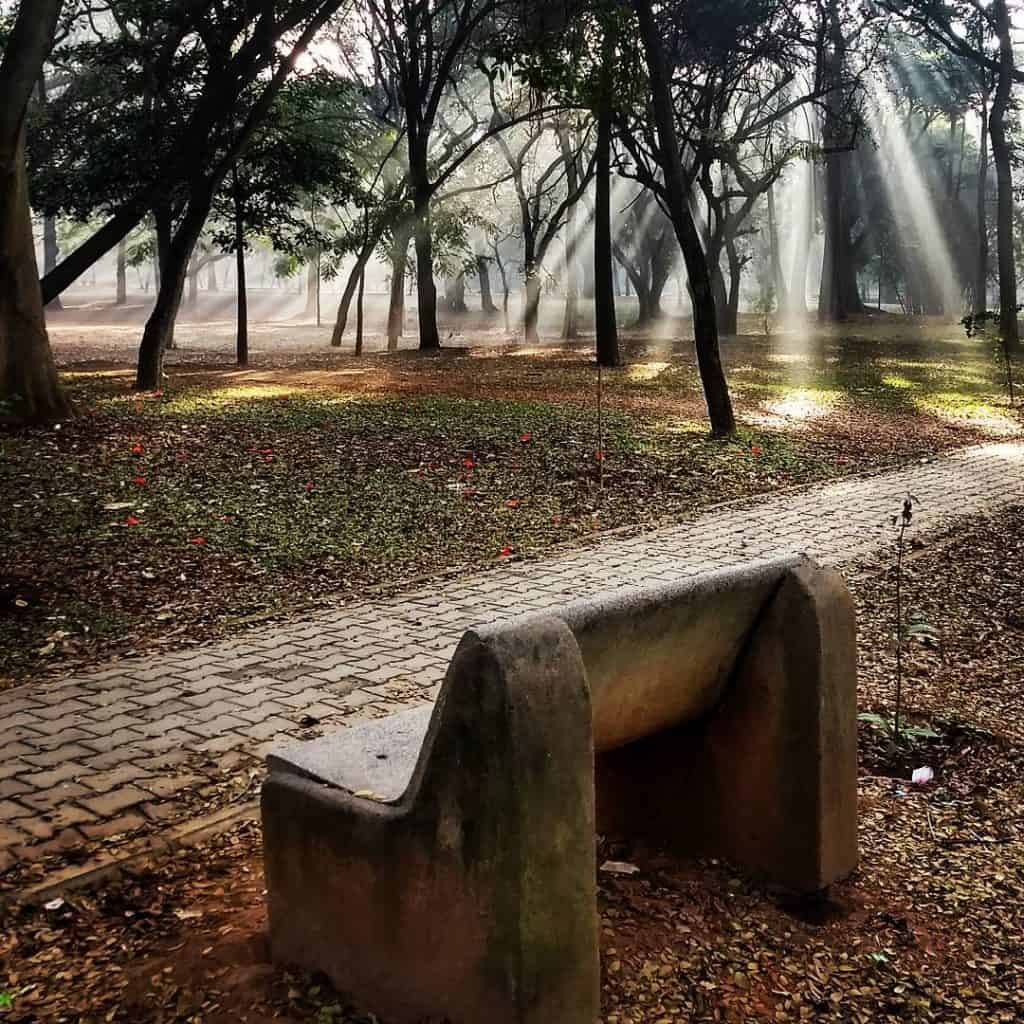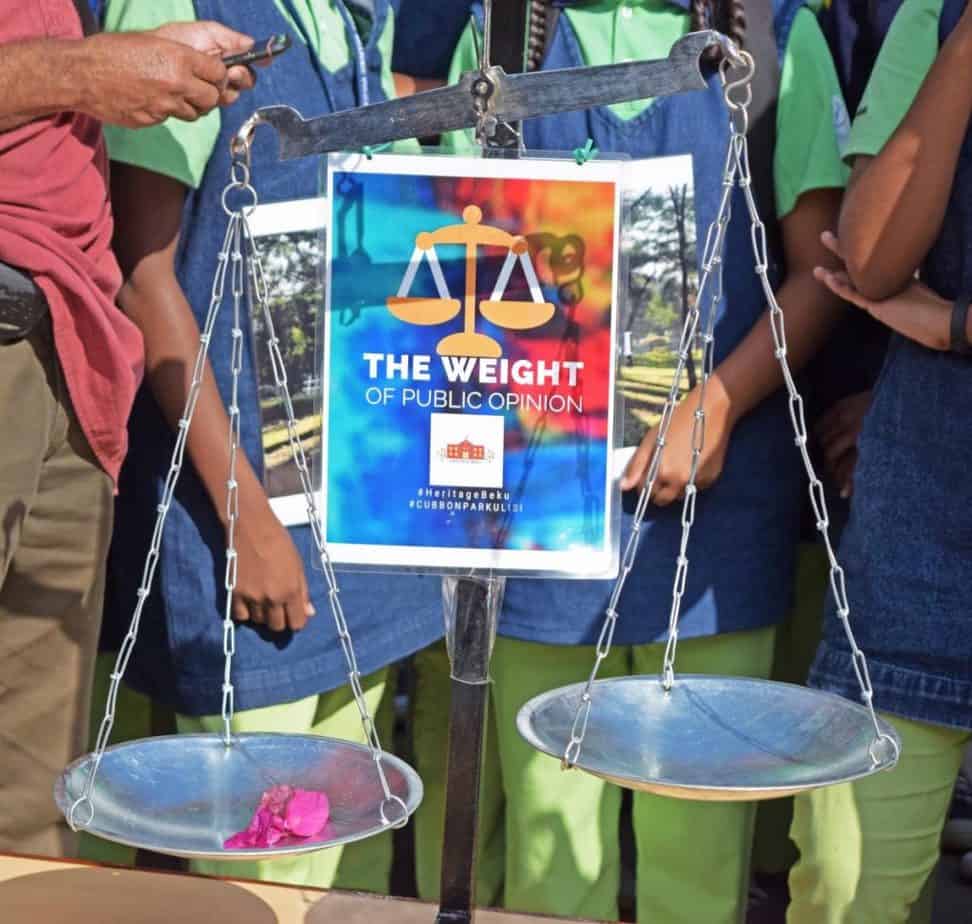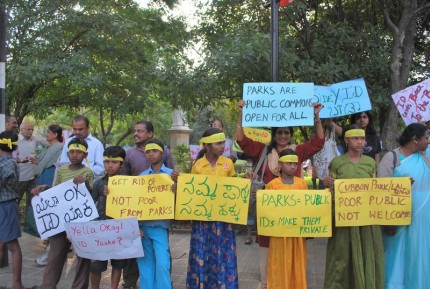Can the government modify or usurp public spaces as to wishes to? Or should it be the people’s decision? This question has been the crux of the multitude of protests to protect Cubbon Park since the 1990s.
The park, which spread across 300 acres at one point, was portioned for government buildings along with some private ones over the years. As per a state government notification of 2015, after excluding the land used up for various establishments, the park area now stands at 197 acres.
The Karnataka Government Parks (Preservation) Act, 1975, mandates the government to maintain parks as horticultural gardens and prohibits any land alienation in parks. But, the push for further construction in the park continues, and equally strong is the pushback from citizens to leave the park intact.
From Public Interest Litigations (PILs) to protests, different individuals and groups have taken up various methods to protect the park area over the years.
PILs spanning over a decade
In the 90s, businessman and theatre artist Bimal Desai filed his first PIL on noticing the dumping of debris in the park during one of his morning walks. Though the case was heard for many years, there was no favourable judgement, says Bimal. However, he then filed PILs over several other issues related to the park – a total of 14 cases, spread over a decade.
Some of these cases led to judgements that restricted rallies, traffic and vending in the park, and also led to the protection and revival of its water bodies. All these judgements were given by the then High Court judge Justice M F Saldanha.
Bimal says, “Whenever there was a protest, political parties would have trucks and buses inside the park, even parked on lawns. Thousands of people would be there, the whole park would be vandalised and food would be thrown all over.” In his order, Justice Saldanha ordered a ban on rallies inside the park. Based on Bimal’s other PILs, street vending was banned within the park and allowed only in the peripheries, film shooting was banned; and through traffic was banned in the park between 10 pm and 8 am. Debris dumped in three water bodies in the park – one near Bal Bhavan, another near Venkatappa Gallery, and a third opposite Kanteerava Stadium – were removed to some extent and the water bodies cleaned up based on Bimal’s PILs.
While Bimal had to put considerable effort into procuring information to support his PILs, he says there was support from several committed government officials behind the scenes.

Bimal’s court cases that challenged the encroaching of park land itself were less successful. For example, his PILs against the illegal expansion of the Press Club premises into park area, and against the construction of a Tennis Club in the park, didn’t yield results.
Read more: Planting forests in Bengaluru: Bimal Desai tells you how
However, such PILs posed hurdles to further encroachments and helped build public pressure. When an annexe to the Legislator’s Home started to be built in the park in 1996, Bimal filed a PIL in the HC and got a stay on the construction. But in 1998, the state government worked around this hurdle by denotifying 44 acres of the park’s land for construction. This move led to one of the biggest protests the city had ever seen.
The 1998 campaign for Cubbon Park was a landmark
Sustained reportage by the press was a huge factor during these protests, says Bimal. Dailies gave front-page coverage, especially when celebrities like Girish Karnad took part in the protests. Bimal spoke at schools and colleges about the issue and this prompted other groups to participate.
Like Bimal, many others were helping catalyse the protests, such as the NGO Environment Support Group (ESG). Eventually, the protest saw participation from people of different classes, castes, genders and age groups – from corporate honchos and school students to Dalit activists. It went on for 40 days, and 30,000-40,000 people participated, says Leo Saldanha of ESG.
“Different groups had different viewpoints, and they participated for different reasons – for example, women’s groups felt it [denotification] would limit women’s right to open spaces. The corporate sector was unhappy with the then government’s rule, and this was a channel for them to express it. But we were able to reach a consensus – that the state cannot encroach public spaces without deeply engaging with the democratic process,” says Leo.
The protest emphasised the idea of the ‘commons’ and people’s right to access public spaces freely – a thread that has continued in future protests related to Cubbon park. “What we were saying was that the State cannot arbitrarily make decisions on the commons, and that it’s up to the public to decide,” says Leo.

In fact, Leo says that the 1998 protest influenced several future campaigns in the city and the state, on citizens’ right to access parks and other public spaces freely, without entry fees or restrictions.
On why the protest was so impactful, Leo says, “The protests were held in different venues, with different groups of people from across the city, which made it inclusive. We wrote letters, we spoke to people over phone, held meetings.” He says it was democratic unlike social media campaigns now: “In the case of online petitions, the group that starts the petition takes a particular position and then seeks others’ support. But when people from diverse groups participate in a campaign, there are conversations about how the commons should be.” The commons can be shaped based on the needs of people, that emerge out of these conversations, says Leo.
However, the High Court later vacated the stay and allowed the construction of the Legislators Annexe building (hearing Bimal’s PIL clubbed with similar PILs). Hence the building was constructed. But the court also ordered that no further construction should be done in the park without getting prior clearance from the HC.
The struggle continues to preserve Cubbon Park
Despite this, illegal constructions have continued in Cubbon Park, says Advocate S Umesh, President of the Cubbon Park Walkers’ Association which was formed in 2012. At establishments like the Tennis Club, unauthorised use, as well as constructions, were continuing without permission from the Horticulture Department which is in charge of the park, he says. “We held in protests in 2012, and in 2013 I filed a case with the Lokayukta. Though the Lokayukta ordered that unauthorised constructions be stopped, officials gave permissions orally after a few years, and the constructions continued,” says Umesh.
Umesh says he also approached the ACB (Anti-Corruption Bureau) and filed complaints against officials at the government’s DPAR (Department of Personnel and Administrative Reforms), without much result.
In late 2019, to the shock of many, the High Court permitted the government’s proposal to construct an annexe building for the HC itself in the park. A heritage building was supposed to be demolished, and the new building was to be constructed in its place. Once again, people from across the city mobilised to object.
Read more: New construction in Cubbon Park: High Court permits 7-storey building, citizens to protest
One of the most prominent voices was that of the citizen collective Heritage Beku. Priya Chetty-Rajagopal who is part of the group, says, “We came together formally from Heritage Beku, to make sure that there was a very stoic, pragmatic pushback; we did not call it a protest. We focused on the natural heritage which is Cubbon Park, and the fact that no further construction is allowed as per law. But our helplessness was because the court had allowed it. So we did a series of articles, conversations, and involved a number of people.”
Sustained press coverage helped the campaign this time too. Priya explains the different aspects of their campaign that helped make it impactful. A cartoon created by cartoonist Nala Ponnappa on the future of Cubbon Park helped spread the message. They also brought the community together – historians like Suresh Moona who talked about the park, eminent personalities like Arundhati Nag who came with their grandchildren and discussed how the park would be for future generations, along with different users of the park – skaters, beggars, joggers, etc.

Such demonstrations helped the group put forward their point strongly. And the state government shelved the project soon. However, citizen activists believe there would be further attempts to encroach Cubbon Park, and that its area could reduce substantially.
Umesh believes in taking the legal route. Last year, he filed a PIL at the High Court, pleading for the demolition of all unauthorised constructions in the park. However, after having fought several PILs for the park, Bimal Desai feels the legal method is very unpredictable: “If people have the guts to come out – not in hundreds, but in lakhs – the government will rethink the whole thing. I feel that only if the government has the will, the park will be protected. Other wise, what can you do?” Bimal believes social media can help mobilise large crowds, like in the case of the steel flyover protests in 2017.
Many imaginations of one park
The contestations over Cubbon Park is not just on how the land is used, but also on how citizens should use the park and who gets access. For example, while one of Bimal’s PILs led to street vending being restricted to the entrances of the park, Maraa, a media and arts collective, has been talking about democratising the park space. Maraa has been working with various communities that use the park, since 2008.
Ekta Mittal, co-founder of Maraa, says, “Vendors have been threatened by cops saying there are surveillance cameras and they’d get caught. They actually have histories of being in the park – their parents used to sell here. But now, even if they come to the park, it’s at their own risk.” She says that the trans community and couples are also at risk. “It’s assumed that if you’re a trans person, you got to be begging or doing sex work. So this group was systematically thrown out of the park and many were severely abused by the police.” Couples, especially those who appear Muslim, have been taken to the police station and their parents called and made to pay a fine, says Ekta.
Ekta says that the park should be made safe for all categories of users, and that different kinds of uses – including rallies – should be allowed. “Of course, there could be limits and restrictions, but that has to be participative. It will have to involve planning with different kinds of people.”

Citizens’ negotiations with the government on the park’s modifications continue as well. Recent examples are the demands for a traffic-free Cubbon Park, and protests against changes proposed under the Smart City Project.
While citizen initiatives continue to protect the park, these contestations continue.
CITIZENS FOR CITIZENS (C4C) has carried out campaigns to stop HONKING within Cubbon Park. We have petitioned Joint Commissioner of Police Dr Ravikanthe Gowda to notify Cubbon Park as a SILENT ZONE so that Honking ban can be enforced. Meanwhile we will continue with our campaign.